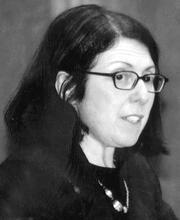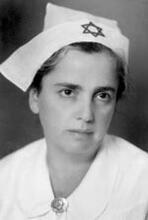Zosha Posnanska
One of the unsung Jewish heroes of World War II, utopianist Zosha Posnanska fought the Germans by aiding the Soviet military. As a member of their intelligence network she provided information crucial to the Allies until she was captured by the Germans and committed suicide at the age of thirty-six. She appears here in Brussels in February, 1933.
Institution: Yehudit Kafri
Zosha Posnanska was born in Poland in 1906 and was politically active in the socialist Zionist movement, Ha-Shomer ha-Za’ir, beginning at the age of fourteen. In 1925, Posnanska moved briefly to Palestine, where she lived on a kibbutz with friends. Posnanska was an active member of the Palestinian Communist Party (PKP). .In 1930, Posnanska left Palestine, where the PKP was illegal, for France. In 1938, Leopold Trepper, whom she had met through the PKP in Palestine, recruited Posnanska to work on establishing a western European intelligence network, dubbed the “Red Orchestra” by the Germans. After becoming a skilled encoder, Posnanska was captured by the Germans, who imprisoned and tortured her for information. Steadfast in her silence until the end, Posnanska hanged herself in her cell in 1942.
Background
Sofia (Zosha) Posnanska, one of the unsung Jewish heroes of World War II, lived only thirty-six years, three of them during the war in Europe. Zosha, Zoshka or Zoha, as she was called by her friends, was born on June 8, 1906 in Łódź, Poland, to Hannah (Anna) Basz and Maurizio (Moshe) Posnanski, whose father was the cousin of Israel Kalmanovich Posnanski, the well-known textile industrialist of Łódź. Her older brother, Olek (Alexander), was born in 1904; her younger sister Manyusha (Manya) was born in 1908.
A short while later the family moved to Kalisz and lived on the beautiful, elegant Alia Jozefina Street. In 1924 Posnanska completed her studies at the girls’ gymnasia in Kalisz. In 1920 she joined the Zionist-socialist youth movement Ha-Shomer ha-Za’ir, which was founded in 1913 and established in Kalisz in 1917.
Posnanska’s first love was Fiszek Kampinsky (later Kafri), whom she met at Ha-Shomer ha-Za’ir. Together with Posnanska’s brother Olek and others, Kampinsky was among the founders of the movement in Kalisz, where Posnanska absorbed the values and the intellectual and political views which became the most important formative factors of her life.
Political Action in Israel
In 1925 Posnanska immigrated to Israel as a pioneer, joining her friends in the A voluntary collective community, mainly agricultural, in which there is no private wealth and which is responsible for all the needs of its members and their families.kibbutz camp in Afulah who later established Kibbutz Mishmar ha-Emek. However, Posnanska did not go with them to establish a kibbutz in Palestine. She had great difficulty accepting the socio-political reality of the country, which at the time was ruled by British imperialism and where the Zionist residents bought land from Arab effendis, which often caused the expulsion of the Arab tenant farmers who lived on the land. According to her socialist view, the land was supposed to belong to the peasants who worked it and not to the effendis. As for British imperialism, in Posnanska’s opinion it had no place in Palestine. After approximately a year Posnanska left her friends in the kibbutz camp, joined the Ihud, a Communist Front movement, and later the PKP (the Palestine Communist Party).
At the beginning of 1930, she moved to France since the PKP was not legal in Palestine and her comrades were sooner or later expelled by the British. While still in Palestine she became acquainted with Shmuel Cinnamon, also a Communist, who preceded her to France. She remained connected with Cinnamon until the end of her life, though the relationship was not smooth and they separated and reconciled many times.
A World Without War
Until her death twelve years later, Posnanska lived alternately in Paris and Brussels, where she belonged to the groups of Jewish left-wing immigrants who came from Eastern Europe and also continued their Communist political activity in the west. Their communism was not, however, the notorious communism of Stalinist terror but a total ideology at whose root was the aspiration to redeem humanity from its suffering, distortions, and sorrow and to create a world of human brotherhood, with neither exploiters nor exploited, without rulers or ruled, without violence and war, a humane world forever free of hunger, disease, racism, ignorance, superstition, and evil—one based on a rational, egalitarian world view, on the good in human beings. She and her comrades believed that the problem of the Jewish people would also be resolved in such a world. During the 1920s and the 1930s, many Communists believed that such a human utopia was possible and achievable. Like many of her comrades, Posnanska dedicated her life to this idea. In Paris and in Brussels Posnanska worked as a factory laborer, cared for children, and performed other lowly underpaid tasks, while at the same time working in every possible way to realize her own and her comrades’ communist vision.
While still in Palestine, Posnanska met Leopold (Leiba) Trepper (1904–1982), one of the PKP leaders there. Trepper, who was also expelled from the country, arrived in Moscow in 1932. In 1938 Soviet army intelligence gave him the task of establishing a Soviet intelligence network in Western Europe, which the Germans referred to as the “Red Orchestra” when they set out to destroy it.
Recruitment by Soviet Intelligence
The first to be recruited by Trepper were his comrades of the PKP in Palestine, including Posnanska, who comprised the network’s inner circle. Trepper had become acquainted with Posnanska in Palestine, had worked with her and greatly admired her. Service in the intelligence network in a foreign country was difficult and dangerous. Though she could have refused, she agreed because, like Trepper himself and the rest of the members, she did not view the work as espionage for its own sake but as one of the revolutionary avenues for realizing the pan-human communist vision. Ironically, between 1939 and June 1941, Posnanska and her comrades were providing information to a USSR that had signed a pact with Nazi Germany.
By 1940 most of Western Europe was under German control. The conditions for Soviet intelligence activity became a great deal more difficult. Posnanska could have refused to continue with it. She even obtained a visa for her friend Sonia Kestner, who used it to flee from France to the United States, but did not obtain one for herself. When asked why Posnanska did not obtain a visa to save herself as well, Sonia replied: “She had a job to do.” She fought the Nazis in the unusual arena of a Soviet military intelligence network. It should be remembered that between June 1941 and June 1944 the Soviet Army was the main military force and almost the only one that fought against the Germans on European soil. At that time the fate of the world depended on its victory or defeat, and intelligence played a fairly important role in its fighting capability. Posnanska’s job in the network was that of an encoder in the broadcasting unit, which was located in occupied Brussels. During the first months of the German invasion of Russia, this was almost the only active broadcasting unit of the network. Most of the intelligence gathered in Germany, France, the Netherlands and Belgium was sent through it to the intelligence center in Moscow. It had to perform a huge amount of work and, contrary to all the rules of security, it did not broadcast for twenty minutes at various times, which would have made it very difficult to locate, but for five hours every night. The intelligence transmitted to the Soviet Army was extremely vital and included all the many and varied aspects of the German military machine. Hitler, who said, “The Russians surpass us in one area—espionage,” ordered the destruction of the network at any price. The broadcasting unit—two radio operators, a homemaker and Posnanska, its only encoder—was captured by the Germans on December 13, 1941 after half a year of activity, in the last three months of which Posnanska had been involved.
Capture and Death
The radio operators and Posnanska were imprisoned. For nine and a half months she remained in their hands, interrogated with bestial cruelty by the Gestapo. A cellmate who survived recalled that she returned from these interrogations more dead than alive. Leopold Trepper, the network’s commander, said later that had she talked, the “Red Orchestra” network would have fallen immediately. She knew the code, which the Germans labored in vain for many months to crack, and knew the high-ranking members of the network. On September 28, 1942, she hanged herself in her cell, remaining silent to the end. The State of Israel awarded her a posthumous decoration as a fighter against the Nazis.
Posnanska was a beautiful woman and a very beautiful human being, possessed of an extraordinary inner strength.
Kafri, Yehudit. Zosha: From the Jezreel Valley to the Red Orchestra (Hebrew). Jerusalem: 2003.
Tarrant, V. E. The Red Orchestra: Soviet Spy Network Inside Nazi Germany. London: Arms and Armour Press, 1995, New York: 1996.
Trepper, Leopold. The Great Game: Memoirs of the Spy Hitler Couldn’t Silence. New York: McGraw-Hill, 1977.
U.S. Central Intelligence Agency. The Rote Kapelle: The CIA’s History of Soviet Intelligence and Espionage Networks in Western Europe, 1936–1945. Washington, D.C.: University Publications of America, 1979.














